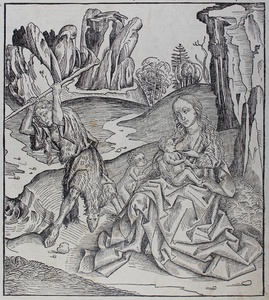| Method | Woodcut |
| Artist | Michael Wolgemut |
| Published | [Anton Koberger, Nuremberg, 1493] |
| Dimensions | Image 255 x 222 mm, Sheet 428 x 290 mm |
| Notes |
A large woodcut illustration of Adam and Eve in the Wilderness, from the celebrated Nuremberg Chronicle. The woodcut, likely engraved by Wolgemut himself, is featured as part of Hartmann Schedel's discussion of the First Age of the World. Having been expelled from the Garden of Eden, Adam and Eve are forced to live a life of toil and difficulty. Adam, dressed in a rough robe of animal skin, hacks at the rocky ground with a crude hoe made of a pointed stick. On a tussock to the right of the scene, Eve sits breast-feeding her infant sons, Cain and Abel. A path behind the couple leads between the cliffs of a rocky ravine, with a group of trees in the distance suggesting the lost paradise of the Garden. On the verso, a large cruciform woodcut illustration shows the genealogical tree of Adam as a literal tree, with its roots emanating from the patriarch's chest. The tree splits into three branches. Cain and his wife on the left and Abel and his wife on the right each offer a sacrifice on an altar in front of them. Abel's sacrificial lamb is accepted by God in the guise of flaming lightning, leading to his murder by Cain in a fit of jealous rage in a scene at below left. Below Adam on the central branch of the tree are the first two decendants of his third son Seth, Enos and Caynan, the line from which Noah, and thus the modern human race, will one day spring. The Liber Chronicarum, usually referred to in English as the Nuremberg Chronicle or in German as the Schedelsche Weltchronik, is, after the Gutenberg Bible, likely the most famous of all early printed books. A colossal chronicle of biblical history, the text covered the seven ages of the world, from Creation to the contemporary world of fifteenth century Europe, and the coming of the Last Judgement. The text, written in Latin by Hartmann Schedel and translated by Georg Alt for the German edition, was mostly a composite of earlier biblical, scientific, philosophical, and historical works. What set the Chronicle apart from its contemporaries was less the quality of its text than its illustrations, which were carved in their hundreds by the workshop of Michael Wolgemut. The illustrations for some of these blocks may have been executed by the young Albrecht Durer, who was apprenticed to Wolgemut at the time. Estimates suggest that up to 1500 copies in Latin may have been printed, as well as between 700 and 1000 German copies by the publishing house of Anton Koberger. In an attempt to prevent piracy, the blocks were kept under lock and key, and returned to the patrons of the work following printing. Michael Wolgemut (1434-1519) was a German painter, printmaker, and sculptor, whose significant achievements are now largely overshadowed by his much more lauded pupil, Albrecht Durer. His most memorable contribution to the arts is his involvement in the production of the woodcut illustrations for the Nuremberg Chronicle, one of the most important incunabula. Wolgemut's studio, including the young Durer, produced almost two thousand illustrations for this work, and Wolgemut is rightly credited as one of the key figures in securing the primacy of German woodcut printing in the late fifteenth century. Condition: Horizontal crease to top of sheet, not affecting larger illustration. Dirt staining to margins, particularly to bottom right corner of sheet. Old adhesive tape to edges of sheet, not affecting image or text. Latin letterpress text above image, and in two panels on verso. |
| Framing | unmounted |
| Price | £400.00 |
| Stock ID | 50700 |

